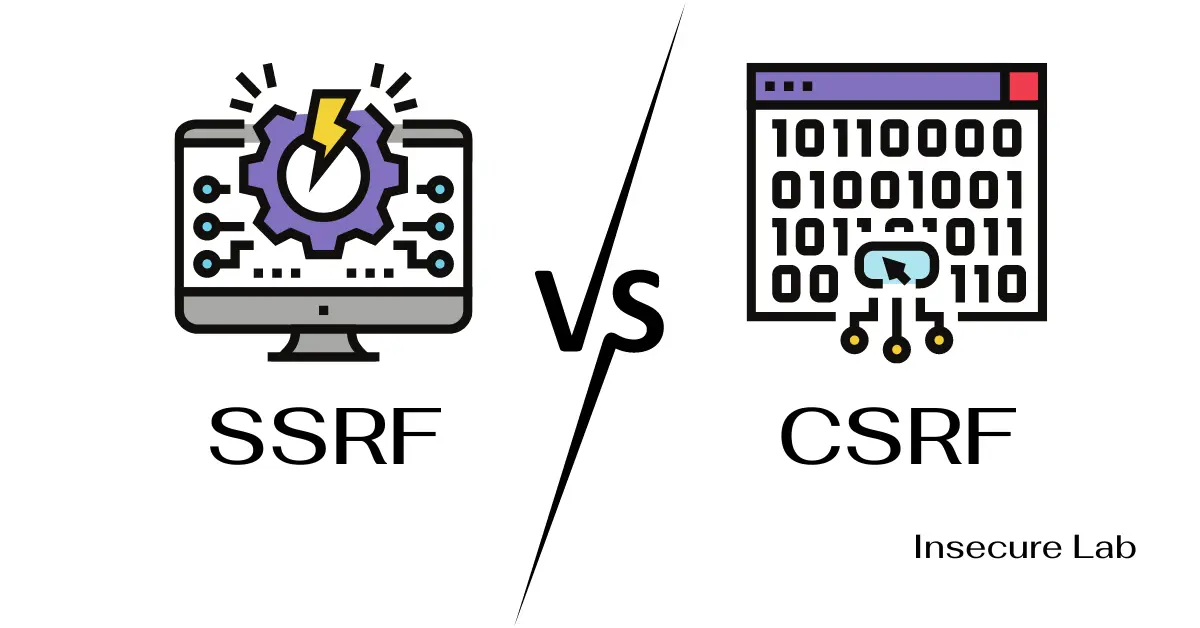Table of Contents
In this comprehensive comparison of SSRF vs CSRF attacks we will explore the key differences between them on various aspects of cybersecurity.
SSRF and CSRF
Both SSRF (Server-Side Request Forgery) and CSRF (Cross-Site Request Forgery) are web application vulnerabilities that attackers can exploit to perform unauthorized actions on behalf of a victim user. These attacks can have serious consequences, including data breaches, unauthorized access, and more.
Understanding the distinct characteristics of SSRF and CSRF attacks helps in implementing the right security measures to protect against these types of vulnerabilities.
Server-Side Request Forgery (SSRF)
SSRF is a type of vulnerability where an attacker tricks a web server into making unauthorized requests to other internal or external resources, potentially exposing sensitive data or exploiting internal systems. It occurs on the server side and can lead to data leakage or unauthorized access.
Cross-Site Request Forgery (CSRF)
CSRF is an attack where an attacker tricks a user’s web browser into executing malicious actions on a different website where the user is authenticated, potentially leading to unauthorized transactions or changes to the user’s account settings. This attack takes advantage of the trust users have in their authenticated sessions.
SSRF vs CSRF
Server-Side Request Forgery (SSRF) and Cross-Site Request Forgery (CSRF) are both security vulnerabilities, but they differ in their nature, attack vectors, and impact.
Difference Between SSRF and CSRF
Below table provides an overview of the key differences between Server-Side Request Forgery and Cross-Site Request Forgery attacks on various aspects.
| Aspect | SSRF (Server-Side Request Forgery) | CSRF (Cross-Site Request Forgery) |
|---|---|---|
| Attack Target | Server-side applications and services | User’s web browser |
| Attack Objective | Abusing server resources or accessing internal systems and data | Performing unauthorized actions on behalf of an authenticated user |
| Execution Location | Performed on the server-side | Performed on the client-side (browser) |
| Attack Trigger | Triggered by an attacker’s input to the server, often through a manipulated URL or parameter | Triggered by a victim’s interaction with a malicious web page or link |
| Authentication Requirement | Usually does not require authentication | Requires an authenticated user session |
| Victim Involvement | Victim is often unaware of the attack | Victim is tricked into executing actions without their consent |
| Targeted Application | Can target internal or external services, including HTTP requests | Typically targets web applications, affecting user actions on websites |
| Attack Variants | Blind SSRF, Time-based SSRF, and Out-of-Band SSRF | Basic CSRF, Session Riding, and Clickjacking |
| Exploitation Difficulty | SSRF can be complex to exploit and may require knowledge of internal network structures and services. | CSRF is relatively easier to execute as it relies on tricking users into taking certain actions. |
| Impact | Can lead to data exposure, service manipulation, and potential lateral movement within a network | Can perform actions on behalf of the victim user, such as changing passwords, making unauthorized transactions, etc. |
| Defense Mechanisms | Input validation and whitelisting, network level protections (firewalls), and host hardening | Anti-CSRF tokens, Same-Origin Policy, and Referer headers |
| Example Attack Scenario | Attacker sends a request to the server to access sensitive internal resources, such as metadata endpoints, local files, or internal services. | Attacker tricks a logged-in user into unknowingly executing an action on a different website, such as changing their email address or password. |
| Common Mitigation Techniques | Secure server configurations, input validation, and firewalls to block outgoing requests to sensitive internal resources | Anti-CSRF tokens, Same-Site Cookies, and validating the origin of incoming requests |
| Severity | Can be severe, as it can lead to data breaches and potential remote code execution | Severity depends on the actions that can be performed via CSRF, but it can result in unauthorized actions on a user’s account |
Summary
While SSRF and CSRF both involve unauthorized requests, SSRF attacks target the server’s functionality directly, often leading to internal network compromise. In contrast, CSRF attacks target the user’s session with a web application, resulting in unauthorized actions being performed on behalf of the user. Both require different defensive strategies and understanding of the underlying mechanisms.

